Cold-rolled corrugated sheets are produced with a polymer layer or without a protective coating. A variety of dimensions allows you to choose the optimal size of the profiled sheet for the roof and apply it in each case. Products come with waves of a square, round, trapezoidal shape, the material is distinguished by the width, height of the corrugation, the base and the type of protective film.
What is a professional sheet
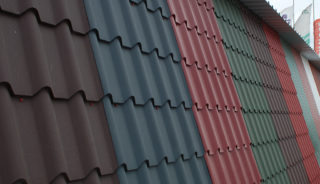
Profiled sheet metal products are produced by cold rolling at factories. The stiffness is provided by the steel base, and the embossing hardens the material without adding weight. The attractiveness is given by the paint coating, and the protective film on the surface increases the resistance to the action of negative factors.
Performance properties depend on indicators:
- thickness of the galvanized layer and base;
- the type of polymer used;
- the thickness of the polymer film;
- distance between waves.
Various types of roof sheeting are produced in two stages. In the first stage, galvanized metal plates are rolled between rollers, as a result, the surface becomes corrugated and repeating waves are obtained. They use steel with a paint and varnish, polymer coating, the color of which is regulated according to the RAL catalog, in other cases, a material without a film is used.
Varieties of polymer layers:
- AK - acrylate;
- PE - polyester;
- PVC - plastic;
- PVDF - polyvinylidene fluoride;
- PUR - polyurethane.
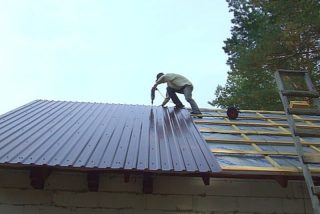
The second operation consists in cutting the material, as a result of which the required dimensions of the profiled sheet for the roof are obtained. The width and length of the products is determined by the state standard, or the dimensions are made according to the customer's order.
Advantages and disadvantages of corrugated board:
- simplicity of design, installation in the mounting position;
- hides surface irregularities;
- sheet length (up to 12 meters) allows you to cover long roofs without joining;
- reliably resists destruction from corrosion, long service life;
- a large selection of colors;
- low weight allows you to reduce the cross-section of the rafters and the thickness of the walls.
The disadvantages of corrugated board use include high sounding when rain drops, birds appear. The effect is eliminated by installing a protective layer against noise in the form of mineral wool or other similar material. When cutting the sheet, damage to the protective film is observed, such a place is weakened and corroded.
Marking and varieties
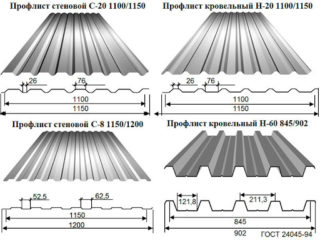
Profiled sheeting for the roof is produced and sorted by size in accordance with the standard standards GOST 24.045 - 2010, which regulate the dimensions, thickness and other parameters of bent profiled sheets for the construction industry.
The marking is as follows:
- H - metal sheets with reinforcement, stacked on roofs, have a high bearing capacity;
- NS - universal products with standard stiffness, placed on roofs and walls;
- C - the material is used in the construction of walls and roofs with a small angle of inclination;
- PC - roofing material of profile section for coatings;
- PG - a special bent type, used in arched roofs, awnings, hangars.
The first type is equipped with additional stiffeners.The PK brand is used as an economical roofing covering for roofs and sheds with a low load and small quadrature.
Manufacturers offer on the market:
- uncoated profiled steel sheets;
- flat varieties without perforation;
- products with a hot-dip galvanized layer and additional protection or without it;
- molded plates of chromium-nickel iron, copper, aluminum;
- embossed sheets for special purposes (special perforation, embossing, bending).
Decking of the first type is in little demand due to insufficient corrosion resistance; it can be welded to load-bearing beams, because as a result, the covering layer is not disturbed. Flat sheets are also used for roofing a house, but rarely.
Dependence of the characteristics of the profiled sheet on the shape of the profile
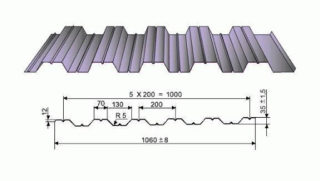
Indicators of length (working) and wave height, sheet thickness are given in the brand name. For example, the designation N75 - 1200 - 05 K indicates that this is an additionally reinforced steel sheet, the height of which is 75 mm, the length is 1200 mm, the thickness is 0.5 mm, and drain grooves are provided. The bearing capacity of all standard types is found in the tables of building reference books. The amount of resistance depends on the thickness of the metal and the shape of the profile, which is semicircular, trapezoidal.
Main settings:
- corrugation height - from 8 to 51 mm and more;
- metal thickness - from 0.3 to 1.5 mm.
Roofing profiled sheet of wave size 8 - 20 mm is used for walls, gates, fences. Any type with a height of 20 mm or more is used for roofing. A height of 44 - 56 mm is placed on roofs with a significant static, snow and wind load, and sheets with a size of more than 57 mm are used as permanent formwork for monolithic concrete sections of the roof covering. The category of bearing material includes grades H60 - H100 mm.
The reference characteristics increase with increasing wave size, while the usable area of the product decreases.
To check the compliance of the geometric indicators of each type of corrugation, there are special tables, where the compliance parameters are given, taking into account the shape. Inaccuracies are allowed, which must be within the permissible specified limits. The check does not apply to the thickness of the steel at the points of wave bends.
The width of the shelves at the edges of the sheet allows for a difference of no more than 2 mm, and the narrower options are marked with a marking strip on both sides of the product. The crescent shape in length should not exceed 1 mm per meter with a sheet length of up to 6 m. On longer sheets, 1.5 mm per 1 meter is allowed.
The waviness of the coating on flat sections of the sheet does not exceed 1.5 mm, the tuberosity of the side shelves is not more than three millimeters. There should be no distortions of the profile.
Required roof slope
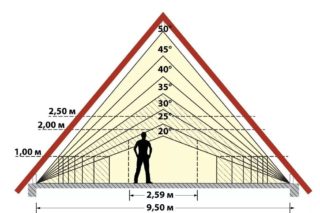
Manufacturers give a guarantee that the corrugated board works well in conditions of a roof slope of more than 12 °, while the maximum slope can be 70 ° or more. According to the norms of SNiP, the recommended angle is normalized at the level of 20 ° as the most rational option. To cover a roof with an average angle of inclination (15 - 35 °), the C21 brand is often taken. The wave height is 21 mm, and the thickness of the profiled sheet for the roof is 0.8 mm, capillary troughs are provided for liquid drainage.
Load-bearing varieties of the H60 - H75 brand are placed on flat roofs, the sheets have a high degree of resistance to static forces. The minimum slope retains water, it is discharged more slowly. Attention is paid to small joints and crevices where moisture can seep. Places of overlap of sheets on each other are sealed with roofing hermetic compounds.
Types of roofs:
- flat coverings are those that are inclined at an angle of no more than 5 °;
- pitched - more than 20 °.
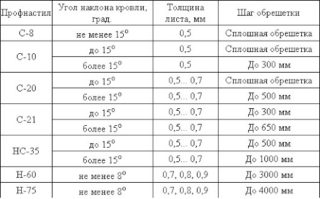
On slopes of a large slope, refined products of the C8 - C12 brand are used. The pressure from the snow on the sheets is minimal, water and moisture from thawing are easily removed outside the coverage. The material has a reduced load-bearing characteristic, it is more difficult to work with a thin profiled sheet.Roofs with a slight slope include those that have a slope of less than 25 °, to an average slope - up to 40 °, decks at an angle of more than 40 ° are considered steep.
Flat roofs are built with reinforced rafters that can support a lot of weight, and pitched roofs involve saving wood on the roof frame. For decking with a slight slope, choose a profiled sheet with a high von, which is more expensive than material with a small ridge height, which goes to pitched roofs.
The minimum slope of the roof from the profiled sheet is determined taking into account the wind pressure, therefore, when choosing the angle, climatic features and the design wind force in the construction region are taken into account. Take into account the weight of the insulation, the weight of the corrugated board, lathing, rafters. The transverse overlap increases with a decrease in the angle of inclination, with an indicator of up to 15 °, the approach of the upper sheet to the lower one is 20 - 25 cm.
Thickness, length and width of the profiled sheet
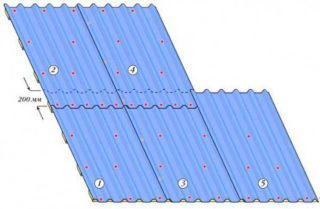
Sheets are produced no longer than 12 meters. The dimensions of a sheet of corrugated board for the roof are cut by some manufacturers in multiples of 0.5 meters, and others - to one meter. Cutting accuracy depends on the quality of the machines. The buyer orders the required length according to the calculation so as not to waste extra material.
More often, a material with a thickness of 0.4 - 0.5 mm is installed on the roof. The strips get their rigidity and strength due to the corrugation, so in standard cases this size is sufficient. Thickness deviations in accordance with GOST are allowed at the level of ± 0.06 mm.
Sheet sizes:
- Н57-750-0.6 - width 750 mm, thickness 0.6-0.8 mm, weight per linear meter from 5.6 to 7.4 kg;
- Н60-845-0.7 - width 848 mm, thickness 0.7-0.9 mm, weight - 7.4-9.3 kg;
- Н57-750-0.6 - width 750 mm, thickness 0.7-0.9 mm, weight - 6.2 - 8.3 kg;
- Н114-600-0.8 - width: 750 mm, thickness 0.8-1.0 mm, weight - 10.2-14.1 kg;
- С21-1000 - width 1250 mm, thickness 0.55 - 0.77 mm, weight - 5.95 - 7.38 kg;
- С44 1000 - width 1250 mm, sheet thickness 0.72 - 0.83 mm, weight - 7.42 - 8.42 kg;
- С15-11.5 - width 1250 mm, thickness 0.6 - 0.75 mm, weight - 5.9 - 7.45 kg.
The corrugated board is produced in accordance with GOST or technical conditions TU 1122.002.4283 - 1965 are applied. The width of the corrugated sheet for the roof changes with increasing or decreasing wave height, so the useful size is always different for different types. When ordering, you need to take into account the useful width so as not to buy missing sheets. The overall width is used in determining the purchase price.
The number of sheets also depends on the overlap in width, which is done for 1 wave, so you need to know its dimensions. The size in width ranges from 750 to 1250 mm, depending on the manufacturer.
Popular shapes and models
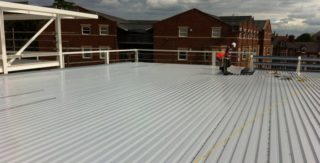
There are many modifications of corrugated board, but there are classic varieties that are most often used when installing roofing.
Popular models:
- C18. Applied on pitched roofs with a slope of 20 °. The material has narrow waves and wide shelves, which is why it receives average strength indicators. Produced galvanized or used a polymer coating.
- C8 and C10. On the roofs they are installed with a continuous crate of OSB panels. The material is used because of its low cost, it is used with a coating or hot-dip galvanized sheets are installed.
- C21. The durable material has an average corrugation width and height. Works well as a roof covering, requires a sheathing step of at least 30 and no more than 65 cm.
- H57. Rigid sheets are placed on flat roofs and used for permanent slab formwork. They use a material with a colored coating, which improves the appearance of the house.
- HC44. HC35. Corrugated panels are used in all construction work where the installation of a profiled sheet is required. They are referred to as a universal type.
There are manufacturers' catalogs for choosing a model and shape. Sheets are purchased in accordance with the operating conditions and material characteristics.








